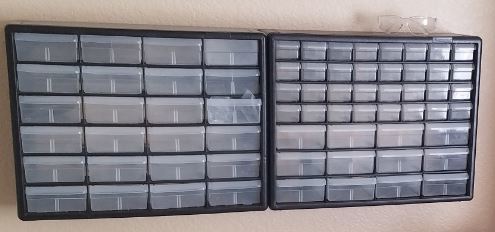Great question! A recent change in my philosophy has forced me to look at this situation. I used to have a HUGE parts stock. LOTS of stuff. little draws, boxes, shelves all over the place. If I needed a part, with a little digging I likely had it. Every sample I ever got, every chip or part I was given from (electronics friends), parts from college, etc… I had it. Then I moved into a small city apartment. In THAT situation I had no place to store stuff, so I put most if it in storage and therefore had very little on-hand.
After a couple years of this I realized it was EASIER for me to just order the parts I needed when I needed them. Amazon sameday/next day shipping is an amazing thing and it was much easier than driving over to my storage garage in the rain/snow/heat/humidity and digging through boxes to find a sub-$1 part. A click on Amazon was much easier.
What this taught me was, I don’t need to have a billion parts in stock to do the type of projects I do. The downside was a day or two waiting for a part could, and did, cause me to get out of my groove and loose momentum in the project. Lost motivation. Other things wedged in etc. So I do stock parts, but just not a ton. I’ve since moved (again) into a larger place I have the room for more stuff, but I kinda liked keeping it minimalist.
What DO I keep in stock? I keep a good stock of common things on hand, LOTS of LEDs, LOTS of switches and buttons especially simple toggles and PCB mounted push-button. A good stock of resistors of the most common values, some POTs of varying styles/values, caps, and some common chips/devices (555’s, 7400 stuff, op-amps, voltage regulators) and as many Arduino pro-micro’s as possible  The goal is to be able to be able to mock-up almost any project or test/dev circuit around any new fancy chip I can without having to run to the store or order something. THEN, if my experiment needs to be built into a permanent form-factor THEN I buy the parts I need to build it and do that.
The goal is to be able to be able to mock-up almost any project or test/dev circuit around any new fancy chip I can without having to run to the store or order something. THEN, if my experiment needs to be built into a permanent form-factor THEN I buy the parts I need to build it and do that.
This has helped me keep tighter control on my parts sprawl. I physically organize in two ways really. Those little component drawers and also little parts boxes.

These are larger things like POTs with BIG knobs, switches, buttons, motors, couple of bare transformers, even some small water pumps, larger relays etc.

These are just resistors, transistors and diodes.

The right side is more/less what I call (in my head) common stock. LEDs, chips, etc. The left side is what I call “niche” or “interesting” parts. Some analog switches, or a part I found online that was neat that I wanted to play with and had extras. That sort of thing.
So because my inventory is small, and grouped in a way that I know more/less where to look for things I don’t really need to inventory stuff. Anything else I just order and wait for it, or run to fry’s (now that I live close to one again!)
That’s what I do…
Brian




